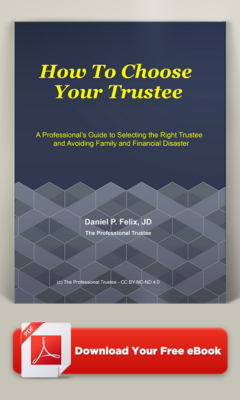Using the PERMA Guides of Positive Psychology to Improve Trust Administration
I’ll bet PERMA doesn’t appear on the check-lists of many trustees. Perhaps it should.
Deeply engaged in the study of how people flourish is a team of positive psychologists collaborating with their thought and practice leader, Professor Martin Seligman.
In his 2011 book “Flourish,” Seligman identified five often-overlapping elements that result in lasting wellbeing. Creating the acronym PERMA, these elements are:
Positive Emotion (P)
Engagement (E)
Positive Relationships (R)
Meaning (M)
Accomplishment/Achievement (A)
PERMA can be a helpful lens to orient administrative efforts towards helping beneficiaries flourish in successful trusts. Let’s take a look at each of the five.
Positive Emotion (P): The trustee can take note of the emotions his actions engender in the beneficiary. He can also try to help connect the beneficiary to positive emotions. These positive emotions can include peace, gratitude, satisfaction, pleasure, inspiration, hope, curiosity, and love.
I know first-hand that this is easier said than done. One of my early beneficiaries said our meetings were worse than her dentist drilling!
That left me a lot of room for growth.
More recently, a beneficiary shifted from feeling burdened with our meetings to feeling empowered. That’s success!
Engagement (E): The trustee can attempt to engage the beneficiary in administration. It may be optimistic to hope that the beneficiary becomes so involved in administration as to experience a state of flow. Nevertheless, there can be a virtuous spiral caused by the beneficiary’s practical and emotional involvement in the direction and details of administration.
Through the use of Distribution Policy Statements and other tools and approaches I’ve had some good success in engaging beneficiaries in administration. I can’t prove it, but I think those beneficiaries are more likely to say their trust is successful because of their being engaged in the process.
Positive Relationships (R): The trustee can establish the foundation of a good relationship with the beneficiary. The other advisors the trustee works with also enhance (or detract from) that core relationship. Paying attention to the process as well as the substance of administration can be a key to success. Relationships really do matter!
No wholesome trustee wants to be in a negative, power-driven relationship, but why do we keep hearing about these destructive relationships? The long list of helpful tools include Appreciative Inquiry, “I-Thou” outlook as well as other approaches that bypass the too-common pitfalls. Responsive and respectful interfacing has served to create a positive, foundational relationship with my beneficiaries.
Meaning (M): The trustee also has many options in connecting the beneficiary and administration to bigger causes. These causes may involve family or family legacy, philanthropy or a business, spiritual ideas or religious groups, or a combination. Going big can help put the smaller issues into perspective. Connecting administration to meaning helps the beneficiary flourish with significance.
I’ve experienced the power of leveraging meaning firsthand primarily through the bigger cause of the beneficiary’s own family. I have noticed the shift in the beneficiary when so connected. Truly wonderful, besides being truly effective!
Accomplishment/Achievement (A): The three primary areas where the trustee can support goals are for the trust, the beneficiary or himself. Such focused striving can be positive in itself. Of course, the achievement of the goal is an objective measure of success. Perhaps one of the best results of trust administration is the trustee supporting the beneficiary to cross the finish line. That’s an event worthy of celebration!
I’ve seen this element work on small goals as well as large. One example of the small: the deliverables out of the trustee’s annual report are put in the context of goals. Great when achieved— and for those that are missed, the beneficiary and I look at what good, if any came, and what do we want to do about it for next year.
By more conscious use of these five building blocks of flourishing, we can provide more successful trust administration.
© 2017 – 2023 Daniel P. Felix, all rights reserved.


